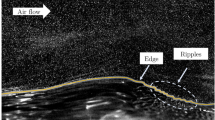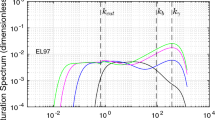Summary
Continuous releases of fluorescent dye were made in the southern North Sea and the power law dependence of the plume width, represented byσ y, against the diffusion time determined. The spreading was non-Fickian and could be represented in the formσ 2y =B 2 t whereB was a diffusion velocity of magnitude 1.4×10−2 m/s. Such spreading was reproduced in both particle tracking and finite difference plume models by allowing the horizontal diffusivity,K H, to depend linearly on diffusion time. The weakness of this method is that it is not clear how the diffusion parameters can be extrapolated to weather conditions that are different to those prevailing at the time of the experiments. However, comparable spreading rates were obtained by combining a Fickian diffusion model with an advective field that represented the near-surface current shears due to wind and waves. The resulting shear diffusion effect produced realistic simulation of the observed dispersion rates. An advantage of this approach is that it enables predictions to be made over a range of weather conditions provided that the wind and wave shears can be accurately parameterized.
Zusammenfassung
Fluoreszierender Farbstoff wurde in der südlichen Nordsee kontinuierlich freigesetzt und die Breite der Wolke, repräsentiert durchσ y, in Abhägigkeit von der Ausbreitungszeit bestimmt. Die Ausbreitung folgte nicht dem Fickschen Ansatz und konnte in der Formσ 2y =B 2 t dargestellt werden, wobeiB eine Ausbreitungsgeschwindigkeit von der Größenordnung 1.4×10−2 m/s darstellt. Eine derartige Ausbreitung wurde sowohl mit Modellen des Partikel-Tracking als auch mit Modellen der finiten Differenzen reproduziert, wobei die horizontale AusbreitungsgrößeKH linear von der Diffusionszeit abhängig war. Die Schwäche dieser Methode ist, daß es nicht klar ist, wie die Diffusions-Parameter für andere Wetterbedingungen als zur Zeit des Experiments zu extrapolieren wären. Vergleichbare Ausbreitungsverhältnisse werden durch die Kombination eines Fickschen Diffusionsmodells mit einem advektiven Feld erreicht, welches die oberflächennahen durch Wind und Wellen verursachten Stromscherungen berücksichtigt. Der so resultierende Scher-Diffusions-Effekt erbrachte ein realistische Simulation der beobachteten Ausbreitung. Ein Vorteil dieses Vorgehens ist, daß es Vorhersagen über einen Bereich von Wetterbedingungen ermöglicht, vorausgesetzt, daß die durch Wind und Wellen verurschte Scherung zutreffend parameterisiert werden kann.
Résumé
A partir de déversements continus de produits fluorescents effectués dans la partie sud de la Mer du Nord, on a pu déterminer l'expression de la largeur du panacheσ y, par son carré en fonction du temps de diffusion. La dispersion n'était pas du type Fickian et était représentée sous la formeσ 2y =B 2 t aB était une vitesse de diffusion de grandeur égale 1.4×10−2 m/s. Une telle dispersion peut être reproduite par une modélisation du panache à la fois par suivi de particules et aux différences finies en admettant que le coefficient de diffusion horizontaleK H dépendait linéairement du temps. L'inconvénient de cette méthode est qu'il n'est pas facile de savoir comment les paramètres de diffusion peuvent être extrapolés à des conditions météorologiques différentes de celles prévalant au moment des expériences. Quoi qu'il en soit, des taux de dispersion comparables ont été obtenus en combinant un modèle de diffusion Fickian avec un champ d'advection qui représentait les cisaillements de courant de surface dus au vent et aux vagues. L'effet de diffusion du cisaillement résultant produisit une simulation réaliste des taux de dispersion observés. Un avantage de cette approche est de rendre possible des prédictions réalisées à travers un éventail de conditions météorologiques à condition que les cisaillements liés au vent et aux vagues puissent être paramétrisés avec précision.
Similar content being viewed by others
Abbreviations
- ΔH :
-
step size during the random walk
- Δt :
-
time increment in particle tracking model
- B :
-
diffusion velocity
- C :
-
concentration
- C A :
-
laterally integrated concentration
- H :
-
water depth
- H s :
-
significant wave height
- k :
-
2π/L, circular wave number
- K H :
-
horizontal diffusivity
- K y :
-
horizontal diffusivity across a plume
- K v :
-
vertical diffusivity
- L :
-
wavelength of the surface waves
- N :
-
number of particles released
- t :
-
diffusion time
- U :
-
advective current speed
- U s :
-
wind-driven surface velocity
- W :
-
wind speed
- z :
-
depth beneath the surface
- z o :
-
thickness of the uniform velocity wind-driven surface layer, analogous to a roughness length
- z c :
-
depth to which wind effects penetrate
- α:
-
wind penetration factor,z c=αL
- σ y :
-
standard deviation of concentration across a plume
- ω:
-
2π/T, circular frequency
References
Allen, C. M., 1982: Numerical simulation of contaminant dispersion in estuary flows. Proc. Roy. Soc. Lond. (A) 381, 179–194.
Asselin, R., 1972: Frequency filter for time integrations. Mon. Weath. Rev.100, 487–490.
Bowden, K. F. and R. E. Lewis, 1973: Dispersion in flow from a continuous source at sea. Water Res.7, pp. 1705–1722.
Bowden, K. F., D. P. Krauel and R. E. Lewis, 1974: Some features of turbulent diffusion from a continuous source at sea. Adv. Geophys.18A, 315–329.
Elliott, A. J., 1986: Shear diffusion and the spread of oil in the surface layers of the North Sea. Dt. hydrogr. Z.39, 113–137.
Elliott, A. J., N. Hurford and C. J. Penn, 1986: Shear diffusion and the spreading of oil slicks. Mar. Pollut. Bull.17, 308–313.
Herterich, K. and K. Hasselmann, 1982: The horizontal diffusion of tracers by surface waves. J. Phys. Oceanogr.12, 704–711.
Ichiye, T., 1967: Upper ocean boundary-layer flow determined by dye diffusion. Phys. Fluids. (Supplement)10, 270–277.
James, I. D., 1987: A general three-dimensional eddy-resolving model for stratified seas. In: Three-dimensional models of marine and estuarine dynamics. (Nihoul, J. C. J. and B. M. Jamart, eds.). Amsterdam: Elsevier. pp. 591–608.
Johnson, J. W., 1960: The effect of wind and wave action on the mixing and dispersion of wastes. Proc. First International Conference on Waste Disposal in the Marine Environment. New York: Pergamon Press, pp. 328–343.
Katz, B., R. Gerard and M. Costin, 1965: Response of dye tracers to sea surface conditions. J. Geophys. Res.70, 5505–5513.
Masch, F. D., 1963: Mixing and dispersion of wastes by wind and wave action. Int. J. Air Wat. Poll.7, 697–720.
McPhee, M. G. and J. D. Smith, 1976: Measurements of the turbulent boundary layer under pack ice. J. Phys. Oceanogr.6, 696–711.
Meerburg, A. J., 1972: An experimental study of the turbulent diffusion in the upper few metres of the sea. Neth. J. Sea Res.5, 492–509.
Richman, J. G., R. A. Szoeke and R. E. Davis, 1987: Measurements of near-surface shear in the ocean. J. Geophys. Res.,92, 2851–2858.
Schott, F., M. Ehlers, L. Hubrich, and D. Quadfasel, 1978: Small scale diffusion experiments in the Baltic surfacemixed layer under different weather conditions. Dt. hydrog. Z.31, 195–215.
Taylor, G. I., 1959: The present position in the theory of turbulent diffusion. Adv. Geophys.6, 101–112.
Thorpe, S. A., 1984: On the determination ofK v in the near-surface ocean from acoustic measurements of bubbles. J. Phys. Oceanogr.14, 855–863.
Author information
Authors and Affiliations
Rights and permissions
About this article
Cite this article
Elliott, A.J., Wallace, D.C. Dispersion of surface plumes in the Southern North Sea. Deutsche Hydrographische Zeitschrift 42, 1–16 (1989). https://doi.org/10.1007/BF02226748
Received:
Accepted:
Published:
Issue Date:
DOI: https://doi.org/10.1007/BF02226748




